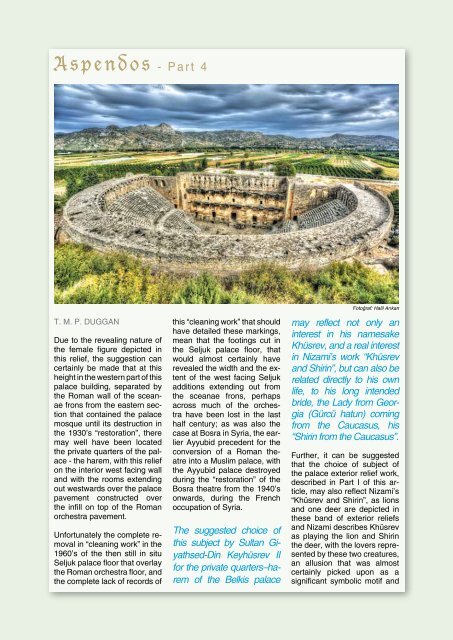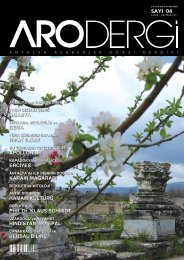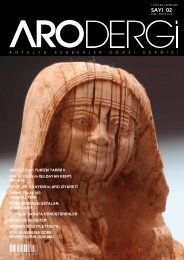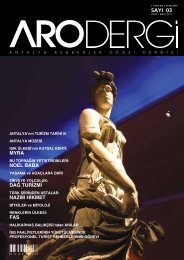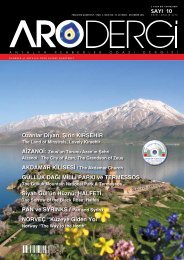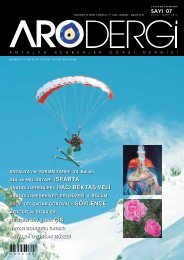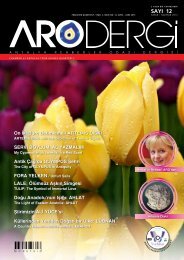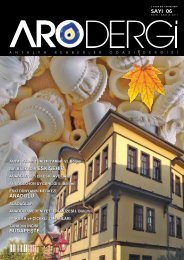Aspendos - 4. BölümT. M. P. DUGGANASPENDOSBelkıs sarayının özel bölümü-haremiiçin, SultanII. Gıyaseddin Keyhüsrevtarafından bu konunun ilerisürülen seçimi, yalnızcaadaşı Hüsrev ve Nizami’nineseri “Hüsrev ile Şirin”eduyduğu gerçek bir ilgiyiyansıtmakla kalmaz, aynızamanda doğrudan kendihayatıyla, uzun süre geliniolmasını istediği, KafkasyalıGürcü hatun, “KafkasyalıŞirin”i ile de ilişkilendirilebilir.Bu kabartmada tasvir edilenkadın figürünün açık doğasınedeniyle, 1930’daki “restorasyon”yıkımına kadar saraycamiini içeren doğu bölümündensahne binasının Romaduvarıyla ayrılmış, bu saraybinasının batı bölümündeki buyükseklikte, sarayın özel bölümününde pekâlâ yer almışolabileceği kesinlikle ileri sürülebilir- batıya bakan iç duvardabu kabartma ve Roma orkestrazemininin tepesindendeki dolgununüzerine inşa edilmiş sarayzemininin üzerinde batıyadoğru uzanan odalarla, harem.Ne yazık ki, Roma orkestra zeminininüzerindeki, o zamanlarhalen yerinde olan Selçuklu sarayzemininin 1960’lardaki “temizlemeçalışmaları” sırasındatamamen ortadan kaldırılmasıve bu işaretleri detaylandırmışolması gereken bu “temizlemeçalışmaları”nın kayıtlarının tamamenyokluğu, dayanaklarınSelçuklu saray zeminini kestiğianlamına gelmektedir. Bunlar,sahne duvarından dışarı uzanan,batıya bakan Selçuklu eklemeleriningenişliğini ve kapsamını,neredeyse kesinlikle,ortaya koymuş olurdu. Sahneduvarının öbür tarafındaki orkestranınçoğu, muhtemelenson yarım yüzyılda kaybolmuştur;Suriye’deki Bosra’dada durum böyle olmuştur.Bosra, bir Roma tiyatrosununbir Müslüman sarayına dönüştürülmesinindaha eski birEyyubi örneğidir. 1940’lardansonra, Suriye’nin Fransız işgalisırasında, Bosra tiyatrosunun“restorasyon”u esnasında, Eyyubisarayı tahrip edilmiştir.Dahası, bu makalenin 1. Bölüm’ündeaçıklanan, sarayındış kabartma eserinin konuseçiminin de, Nizami’nin “Hüsrevile Şirin”ini yansıttığı ilerisürülebilir, çünkü bu dış kabartmaşeritlerinde aslanlarve bir geyik tasvir edilmiştir veNizami Hüsrev’i aslanı, Şirin’ide geyiği oynar olarak tanımlamaktadır.Aşıklar bu iki yaratıklatemsil edilmiştir ve bu daneredeyse kesinlikle önemli birsembolik motif olarak seçilmişve Aspendos’taki bu sarayındış kabartma eserinin tasarımındakullanılmış bir imadır.Belkıs sarayının içindeki veüzerindeki Selçuklu kabartmaeserde somutlaştırılan anlamınbu yorumu, insanın, Belkıs-Aspendossarayının SultanGıyaseddin Keyhüsrev’in aşkıiçin tasarlandığını ve inşa edildiğiniileri sürmesine yol açar.Bu, “Hüsrev ile Şirin”in ilk bölümündeanlatıldığı gibi, uzakve uzun zamandır beklenenbir aşktır. Ayrıca, Aspendos’takisarayın, mutemelen, gelini,Şirin’i, Gürcü hatunu, eşi,Belkıs’ı için bir armağan olarakinşa edildiği de ileri sürülebilir.Böylece, Belkıs ismi, Aspendos’takihem Selçuklu, hem demodern yerleşimlere verilmiştir.Muazzam Belkıs-Aspendossarayının bölümlerine uygulanmışkabartma süslemeleri90>91 ANTALYA REHBERLER ODASI DERGİSİ
Aspendos - Part 4T. M. P. DUGGANDue to the revealing nature ofthe female figure depicted inthis relief, the suggestion cancertainly be made that at thisheight in the western part of thispalace building, separated bythe Roman wall of the sceanaefrons from the eastern sectionthat contained the palacemosque until its destruction inthe 1930’s “restoration”, theremay well have been locatedthe private quarters of the palace- the harem, with this reliefon the interior west facing walland with the rooms extendingout westwards over the palacepavement constructed overthe infill on top of the Romanorchestra pavement.Unfortunately the complete removalin “cleaning work” in the1960’s of the then still in situSeljuk palace floor that overlaythe Roman orchestra floor, andthe complete lack of records ofthis “cleaning work” that shouldhave detailed these markings,mean that the footings cut inthe Seljuk palace floor, thatwould almost certainly haverevealed the width and the extentof the west facing Seljukadditions extending out fromthe sceanae frons, perhapsacross much of the orchestrahave been lost in the lasthalf century; as was also thecase at Bosra in Syria, the earlierAyyubid precedent for theconversion of a Roman theatreinto a Muslim palace, withthe Ayyubid palace destroyedduring the “restoration” of theBosra theatre from the 1940’sonwards, during the Frenchoccupation of Syria.The suggested choice ofthis subject by Sultan Giyathsed-DinKeyhüsrev IIfor the private quarters–haremof the Belkis palaceFotoğraf: Halil Arıkanmay reflect not only aninterest in his namesakeKhüsrev, and a real interestin Nizami’s work “Khüsrevand Shirin”, but can also berelated directly to his ownlife, to his long intendedbride, the Lady from Georgia(Gürcü hatun) comingfrom the Caucasus, his“Shirin from the Caucasus”.Further, it can be suggestedthat the choice of subject ofthe palace exterior relief work,described in Part I of this article,may also reflect Nizami’s“Khüsrev and Shirin”, as lionsand one deer are depicted inthese band of exterior reliefsand Nizami describes Khüsrevas playing the lion and Shirinthe deer, with the lovers representedby these two creatures,an allusion that was almostcertainly picked upon as asignificant symbolic motif and
- Page 1 and 2:
PUBLISHED QUARTERLY, YEAR: 3, ISSUE
- Page 3 and 4:
Yeni Yıl, Yeni Bakan24 Ocak’ta
- Page 5 and 6:
Merhaba Sevgili Okurlar,Acısıyla,
- Page 7 and 8:
A Hidden City in Cilicia:The ANCIEN
- Page 9 and 10:
used in the construction of thissma
- Page 11 and 12:
Zengin içecek çeþitleri,Damak ta
- Page 13 and 14:
ehind and move on for about500 m.,
- Page 16 and 17:
Yüz Yıllık Destan: Hamidiye Kruv
- Page 18 and 19:
Hamidiye Kruvazörü ve Hüseyin Ra
- Page 20 and 21:
Hamidiye Kruvazörü ve Hüseyin Ra
- Page 22 and 23:
Hamidiye Kruvazörü ve Hüseyin Ra
- Page 24 and 25:
Hamidiye Kruvazörü ve Hüseyin Ra
- Page 26 and 27:
Hamidiye Kruvazörü ve Hüseyin Ra
- Page 28:
Hamidiye Kruvazörü ve Hüseyin Ra
- Page 31 and 32:
HÜSEYİN RAUF ORBAYOsmanlı İmpar
- Page 33 and 34:
Yýllýk olarak tahmini uluslararas
- Page 35 and 36:
www.adnansayki.comBOSPHORUS LARASey
- Page 38 and 39:
Kapadokya’nınTarih ÖncesiYrd. D
- Page 40 and 41: Doğu Akdeniz gibi Anadoludışınd
- Page 42 and 43: Kapadokya’nın Tarih Öncesi / Th
- Page 44 and 45: Kapadokya’nın Tarih Öncesi / Th
- Page 46: Kapadokya’nın Tarih Öncesi / Th
- Page 49 and 50: were found in the settlementof Guve
- Page 51 and 52: the Early Bronze Age, is calledCapp
- Page 53 and 54: Those Who Give Sound to the Earth,T
- Page 55 and 56: M. Emin Bolat was born in Iskenderu
- Page 57 and 58: “Kapadokya”DERVÝÞ EVÝGöreme
- Page 59 and 60: Our Thracian Countryman: ORPHEUSSul
- Page 61 and 62: lyre that the wild animalswould get
- Page 63 and 64: Persephone and of Orpheus’Eurydic
- Page 65 and 66: CANKURTARANHALIHayatDokundukçaGüz
- Page 67 and 68: The DoradoAtilla Sukru NILGUN, Tour
- Page 69 and 70: land of Malta. The largest catchesc
- Page 71 and 72: Dostlarla Bir MolaCAFE MOLABon Appe
- Page 73 and 74: dolu’yu, Doğu Akdeniz kıyılar
- Page 75 and 76: Aizanoi: The City of Azan,The Grand
- Page 77 and 78: the corridors of the bath andhere,
- Page 79 and 80: Türk mutfaðýnýn yöresel yemekl
- Page 81 and 82: with columns. Three gatesopening to
- Page 83 and 84: pecially during the Romanperiod due
- Page 85 and 86: GRAFÝK TASARIM - WEB TASARIM - ARA
- Page 87 and 88: pedestrians.It is written on the in
- Page 89: logical Museum of Kutahya,and see t
- Page 93 and 94: was employed in the design ofthis e
- Page 96 and 97: AspendosFotoğraf: Halil Arıkanbun
- Page 98 and 99: Aspendostürülmesinin muhtemelen12
- Page 100 and 101: Dubai:Ortadoğu’nun Parlayan Yıl
- Page 102 and 103: Dubai: Ortadoğu’nun Parlayan Yı
- Page 104: Dubai: Ortadoğu’nun Parlayan Yı
- Page 107 and 108: Dubai, gece görünüm / Night View
- Page 109 and 110: 2012 Yılı Seminerlerini Tamamlad
- Page 111 and 112: ARO Eğitim GezileriDöşemealtı v
- Page 113 and 114: ARO Söyleşileri Devam Ediyor...08
- Page 115 and 116: Basında ARO
- Page 117 and 118: ARO EtkinlikleriÜyelerimize Yönel
- Page 119 and 120: SANCAKTAROÐLUSÝGORTA“Keþke”
- Page 121 and 122: Yukarıdan Aşağıya:1. Ağaç dir
- Page 123 and 124: Hastalýkta saðlýkta...Tel: +90 3


